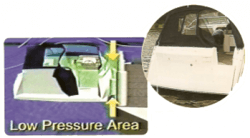Death on Boat from Silent Killer
 Dr. John Doe and his wife, Jane, had everything they had dreamed of: their first child, one-and-a-half-year-old Christopher; a new job for John as provost of the University of North Florida; a new home being built on the intracoastal and a new 34-foot Thompson Santa Cruz cabin cruiser. The boat did not start sometimes, but the marine mechanic told them running it periodically would eliminate the problem. Dr. Doe had planned a weekend cruise to St. Augustine to celebrate Jane's birthday. When his Friday morning meeting was canceled, he saw the opportunity to make sure things would go smoothly for the trip. He went over to the new house to run the boat which was docked at its bulkhead.
Dr. John Doe and his wife, Jane, had everything they had dreamed of: their first child, one-and-a-half-year-old Christopher; a new job for John as provost of the University of North Florida; a new home being built on the intracoastal and a new 34-foot Thompson Santa Cruz cabin cruiser. The boat did not start sometimes, but the marine mechanic told them running it periodically would eliminate the problem. Dr. Doe had planned a weekend cruise to St. Augustine to celebrate Jane's birthday. When his Friday morning meeting was canceled, he saw the opportunity to make sure things would go smoothly for the trip. He went over to the new house to run the boat which was docked at its bulkhead.
It was a typical summer morning, as Dr. Doe turned on the boat's air conditioning and left up the canvas and plastic covering which enclosed the top deck. A few hours later Dr. Doe was found dead from carbon monoxide poisoning. The boat's engines and air conditioning were still running and the boat's carbon monoxide alarm was sounding.
After John's death, Jane could no longer make payments on the house or the boat and had to sell them at a loss. She and Christopher moved back to California to be near her parents. She hired Pajcic & Pajcic to figure out what happened and to protect her and Christopher's financial interests.
Dr. Doe's death was a mystery at first. Where did the carbon monoxide come from and why did he stay on the boat with the alarm sounding?
Pajcic & Pajcic's testing pinpointed the source of the carbon monoxide as the exhaust from the boat's engines coming in through the rear entry flap of the boat's deck covering. This is sometimes called the station-wagon effect, and automotive manufacturers have addressed the problem by eliminating the rear window opening. Despite over a decade of Coast Guard publications on carbon monoxide hazards, the boating industry has not made any analogous design changes.
As a careful and educated man, Dr. Doe was aware of the hazard of carbon monoxide poising and had paid extra to have a carbon monoxide alarm installed on the cabin cruiser. Since the alarm was sounding, why had Dr. Doe not gotten off the boat?
Further testing by Pajcic & Pajcic solved this part of the mystery too. The carbon monoxide alarm was miscalibrated and did not go off until almost an hour after it was supposed to.
Carbon monoxide, sometimes called the silent killer, is a clear, odorless gas which gradually induces a sleep-like stupor. By the time the alarm sounded Dr. Long could no longer help himself.
After proving how Dr. Doe died, Pajcic & Pajcic sued the manufacturer of the boat, the manufacturer of the carbon monoxide alarm and the marina which installed the air conditioning, the deck covering and the alarm.
Pajcic & Pajcic proved the boat manufacturer had given no consideration to the carbon monoxide hazard in its design and no warnings to dealers and customers. Pajcic & Pajcic's experts also criticized the marina for how they installed the alarm and the air conditioning.
Most helpful to the resolution of the case was the discovery of damaging internal documents from the alarm manufacturer. Boat manufacturers complained about the unreliability of the alarms. The defendant's own testing showed repeated malfunctions in the alarms. Prior employees and component part makers criticized the defendant for changes in the manufacturing process which allowed contamination of sensitive components. The defendant could not find text records for this alarm. Based on all the evidence Pajcic & Pajcic sought punitive damages from the defendant alarm manufacturer.
The case settled at the second mediation in September 1997 for case and annuities with an expected payout of $5.4 million and a present value of $3 million. Jane and Christopher have been able to pay for their home in San Jose, California. Jane has the financial ability to be a full-time mother to Christopher, whose education and financial support are fully assured. The University of North Florida has set up a scholarship in Dr. Doe's honor.
